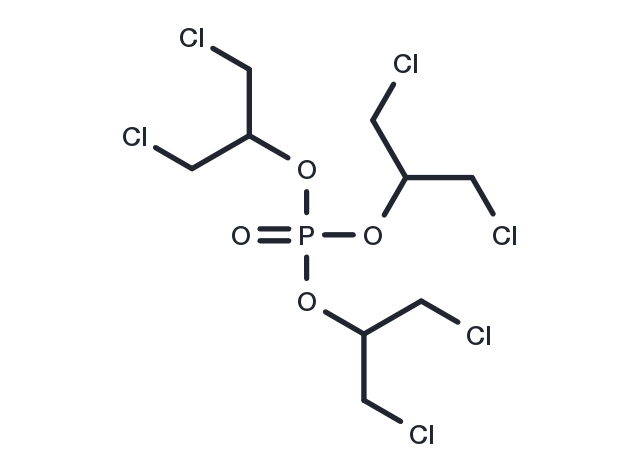Powder: -20°C for 3 years | In solvent: -80°C for 1 year


TDCPP (Fyrol FR 2) is classified under the chlorinated trialkyl organophosphate flame retardant (OPFR) group of compounds primarily utilized as additives in commercial products.

| Pack Size | Availability | Price/USD | Quantity |
|---|---|---|---|
| 50 mg | In stock | $ 43.00 | |
| 100 mg | In stock | $ 59.00 | |
| 200 mg | In stock | $ 80.00 | |
| 1 mL * 10 mM (in DMSO) | In stock | $ 65.00 |


| Description | TDCPP (Fyrol FR 2) is classified under the chlorinated trialkyl organophosphate flame retardant (OPFR) group of compounds primarily utilized as additives in commercial products. |
| In vitro | A dose-dependent decrease of cell viability after TDCPP exposure with LC50 at 202 μg/mL. A concentration-dependent apoptotic sign was observed in HCECs after exposing to ≥2 μg/mL TDCPP. Endoplasmic reticulum stress induction was evidenced by up-regulation of its biomarker genes (ATF-4, CHOP, BiP, and XBP1). Furthermore, alternation of Bcl-2/Bax expression, mitochondrial membrane potential loss, cellular ATP content decrease, and caspase-3 and -9 activity increase were observed after exposing to 2 or 20 μg/mL TDCPP. Implicated the involvement of endoplasmic reticulum stress in TDCPP-induced HCEC apoptosis, probably mediated by mitochondrial apoptotic pathway. TDCPP exposure induced toxicity to human cornea. |
| Cell Research | Human corneal epithelial cells (HCECs) were cultured in DMEM supplemented with 10% FBS, 10 ng/mL EGF, and 1% penicillin-streptomycin solution in an incubator with 5% CO2 at 37℃.?After reaching confluence, HCECs were replanted into 6/24/ 96-well plates or petri dishes with different initial densities and cultured for 24 h to reach ~70% confluence.?Then, TDCPP dissolved in n-hexane was solvent-exchanged to DMSO and serially diluted by DMEM to achieve concentrations from 0.034 to 340 μg/mL.?For cell exposure, the culture medium was aspirated and treated with TDCPP solutions (DMSO <0.1%) for 24 h with 0.1% DMSO solution as vehicle control[1]. |
| Synonyms | Fyrol FR 2, Tris(1,3-dichloroisopropyl)phosphate |
| Molecular Weight | 430.9 |
| Formula | C9H15Cl6O4P |
| CAS No. | 13674-87-8 |
Powder: -20°C for 3 years | In solvent: -80°C for 1 year
DMSO: 60 mg/mL (139.24 mM)
You can also refer to dose conversion for different animals. More
bottom
Please see Inhibitor Handling Instructions for more frequently ask questions. Topics include: how to prepare stock solutions, how to store products, and cautions on cell-based assays & animal experiments, etc.
TDCPP 13674-87-8 Others Fyrol FR 2 Tris(1,3-dichloroisopropyl)phosphate inhibit Inhibitor inhibitor
